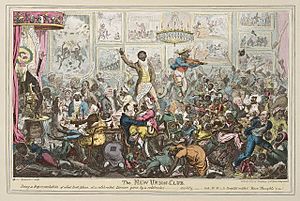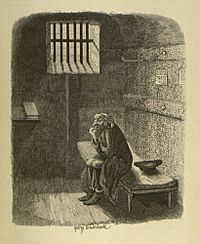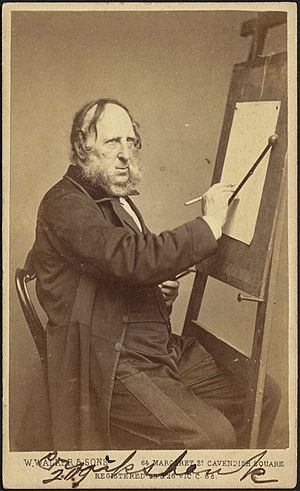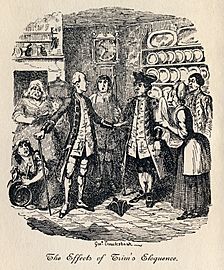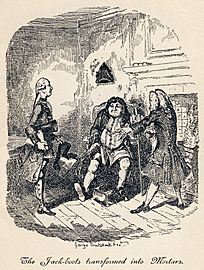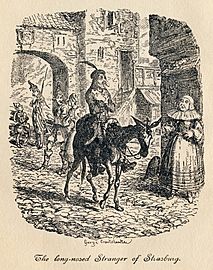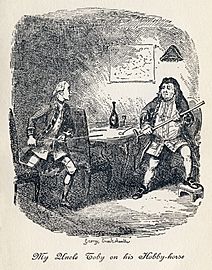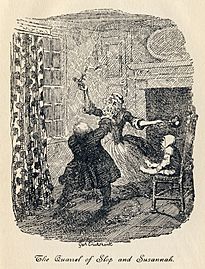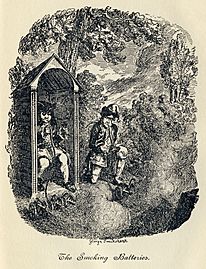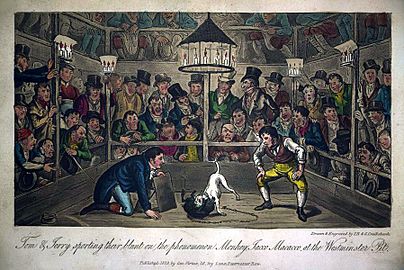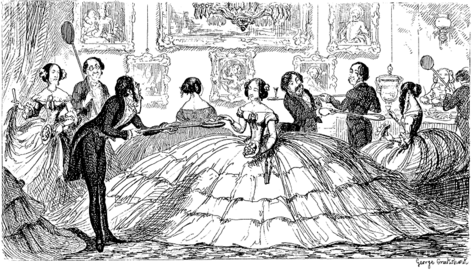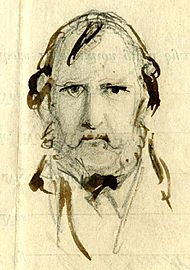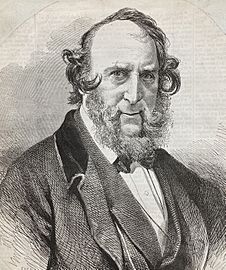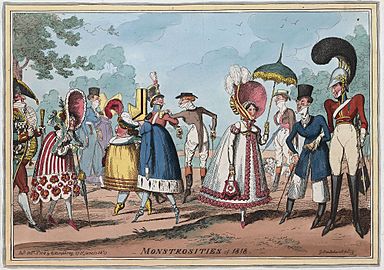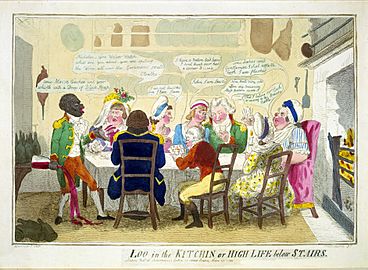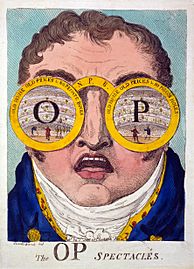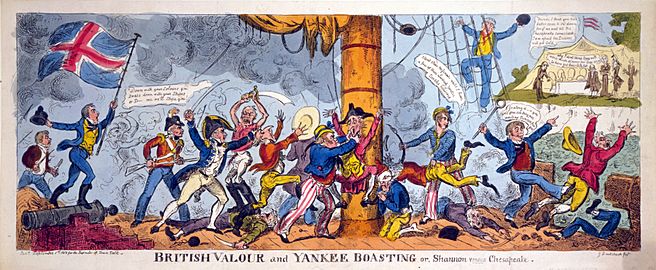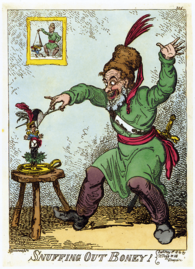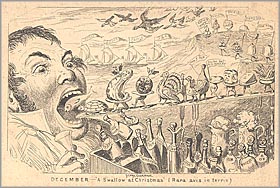George Cruikshank facts for kids
Quick facts for kids
George Cruikshank
|
|
|---|---|
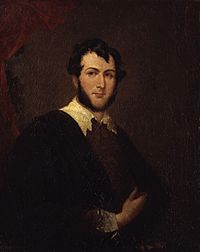
George Cruikshank, 1836
|
|
| Born | 27 September 1792 London, England
|
| Died | 1 February 1878 (aged 85) London, England
|
| Nationality | British |
| Known for | Cartoonist (caricaturist), children's literature |
George Cruikshank (born 27 September 1792 – died 1 February 1878) was a famous British artist. He was known for his funny drawings called caricatures and for illustrating books. During his life, people called him the "modern Hogarth" because his art was so good.
Cruikshank illustrated books for many authors, including his friend Charles Dickens. His drawings were seen by people all over the world.
Contents
Early Life and Art Beginnings
George Cruikshank was born in London, England. His father, Isaac Cruikshank, was also a leading artist who drew caricatures. George started his art career by helping his father. His older brother, Isaac Robert, also became a caricaturist and illustrator.
At first, George Cruikshank mostly drew caricatures. These are drawings that exaggerate people's features for a funny or critical effect. In 1823, when he was 31, he started to focus more on illustrating books. One of his first big book projects was illustrating the English translation of Grimms' Fairy Tales in 1823.
He married Mary Ann Walker in 1827. After she passed away, he married Eliza Widdison in 1851. They lived in North London.
Drawing Social and Political Cartoons
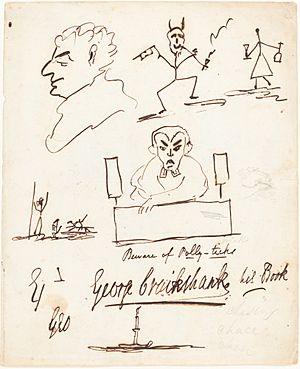
Cruikshank became well-known for his social cartoons about English life. He worked with William Hone on a political cartoon series called The Political House That Jack Built (1819).
In the same year, he created a controversial drawing called The New Union Club. This drawing made fun of a dinner party held by people who wanted to end slavery. While some people liked it back then, today it is seen as a very unfair and racist drawing. He also drew The Belle Alliance, or the Female Reformers of Blackburn!!! (1819), which criticized women's involvement in political movements.
One of his first major works was Pierce Egan's Life in London (1821). This book followed two young men as they explored different places in London. Cruikshank also created The Comic Almanack (1835–1853) and Omnibus (1842).
He became famous for his political drawings that made fun of the royal family and important politicians. In 1820, he even received money from King George IV of the United Kingdom to stop drawing cartoons of him in certain situations. Cruikshank helped develop the character of John Bull, who represents England in many British cartoons.

Cruikshank took over from James Gillray as England's most popular cartoonist. For many years, he drew cartoons about different political groups. He found ideas for his cartoons in every public event, including wars and the enemies of Britain. He was very patriotic.
However, some of his work showed strong dislike for Britain's enemies and included unfair portrayals of people. For example, his drawings for History of the Irish rebellion in 1798 (1845) showed Irish rebels in a very negative and racist way. He also made cartoons about the Chinese people that were considered racist.
Working with Charles Dickens
George Cruikshank illustrated several books for the famous writer Charles Dickens. These included Sketches by Boz (1836), The Mudfog Papers (1837–38), and Oliver Twist (1838). He also illustrated Memoirs of Joseph Grimaldi (1838), which Dickens edited. Cruikshank even acted in plays with Dickens's amateur acting group.
Later in his life, Cruikshank claimed he had helped create much of the story for Oliver Twist. This led to a big argument about who deserved credit for the book. Dickens strongly disagreed with Cruikshank's claim.
Supporting Temperance and Volunteers
In the late 1840s, Cruikshank started to focus less on book illustrations and more on promoting the temperance movement. This movement encouraged people to drink less alcohol or no alcohol at all. He gave talks and provided illustrations for groups like the National Temperance Society.
His most famous works from this time are The Bottle (1847) and its follow-up, The Drunkard's Children (1848). These were a series of pictures showing the negative effects of alcohol. He also created a large oil painting called The Worship of Bacchus, which is now in the Tate Gallery, London. Because of his efforts, he became a vice president of the National Temperance League in 1856.
When there was a fear of invasion in 1859, the Volunteer Movement was created. Cruikshank helped organize groups of Rifle Volunteers. His unit was made up of working men who did not drink alcohol. He faced some challenges with his unit but continued to support the movement.
Later Years and Legacy
As he got older, George Cruikshank's health declined, and the quality of his work began to change. He passed away on 1 February 1878. He was first buried in Kensal Green Cemetery, but later his remains were moved and reburied in St. Paul's Cathedral.
During his lifetime, George Cruikshank created almost 10,000 prints, illustrations, and plates. Many of his works are kept in the British Museum and the Victoria and Albert Museum. A special Royal Society of Arts blue plaque marks his former home at 293 Hampstead Road in Camden Town.
Samples of his work
The Life and Opinions of Tristram Shandy, Gentleman
Other Illustrations
-
An unflattering 1819 caricature of the Prince Regent from "The Political House that Jack Built" by William Hone.
-
Caricature about ticket prices at the Covent Garden Theatre
-
Snuffing out Boney, 1814
See also
 In Spanish: George Cruikshank para niños
In Spanish: George Cruikshank para niños


